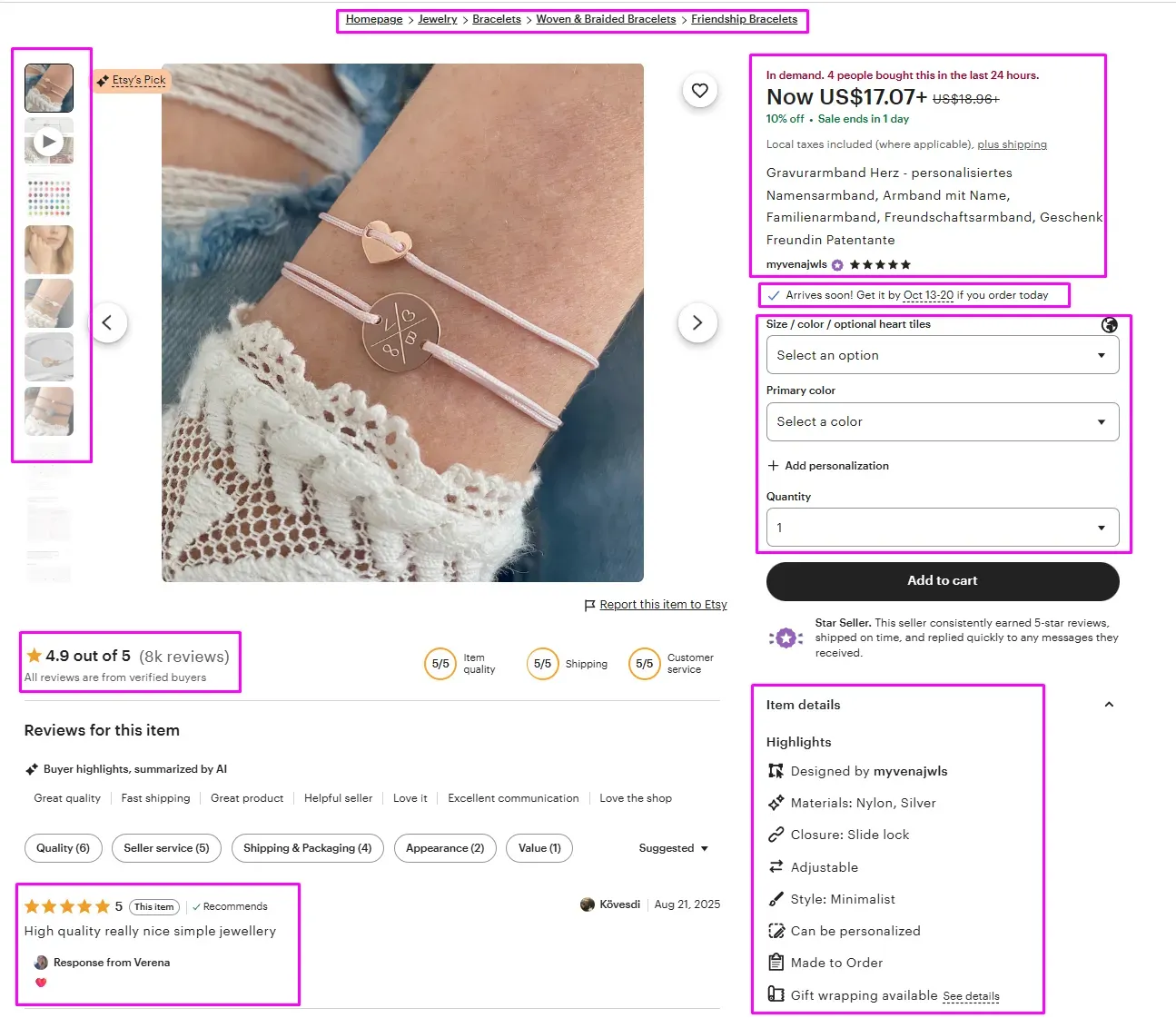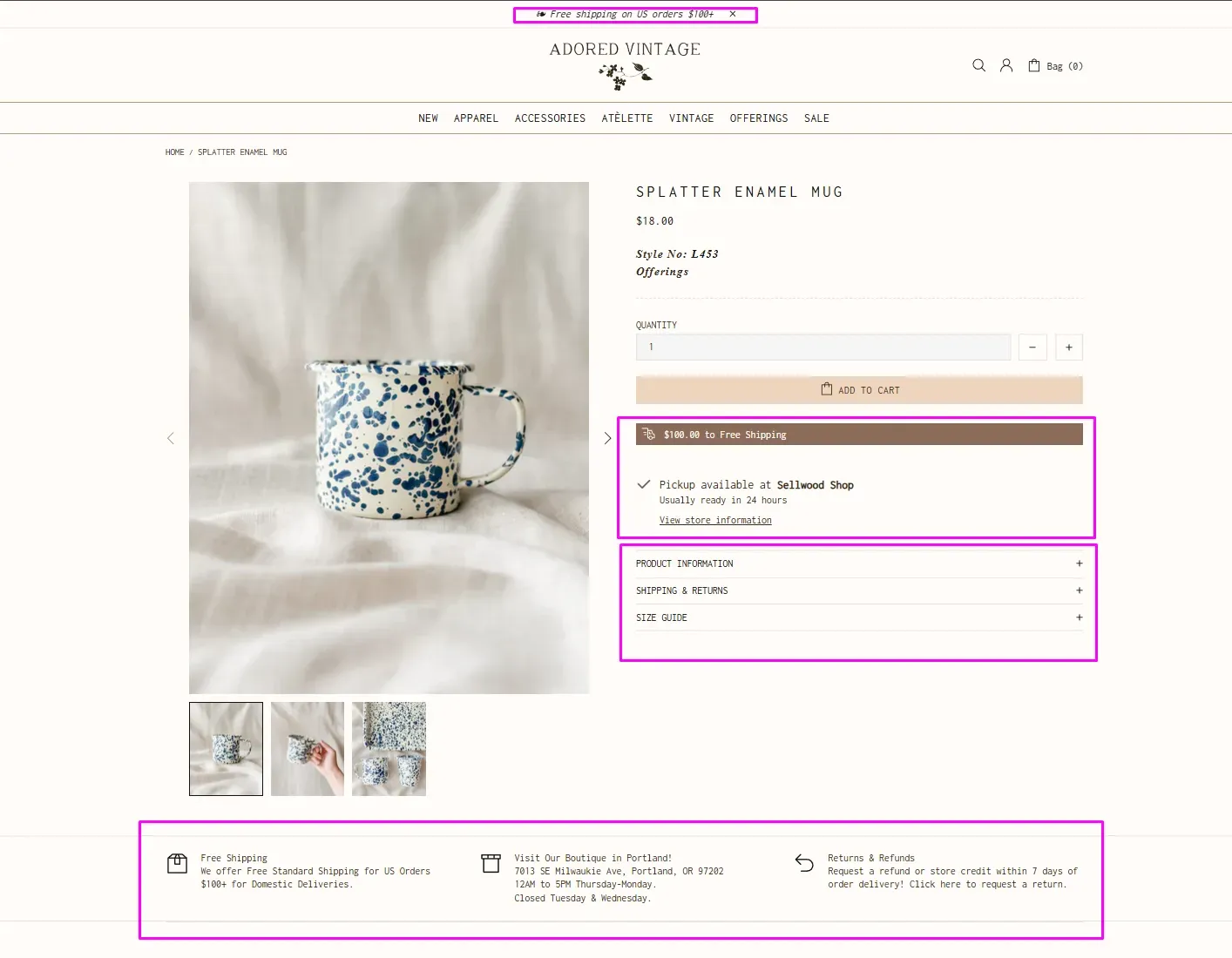In this article, you’ll learn:
What is a PDP in Simple Terms
A PDP (Product Detail Page) is a web page in an ecommerce website where shoppers make their purchase decisions about a specific item.
Simple example: You visit Amazon, click on a pair of sneakers — a page opens with product images, pricing, sizes, reviews, and an “Add to Cart” button. That’s a PDP.
On a PDP, users typically:
- Study product images from every angle
- Compare specifications (size, color, material, product attributes)
- Read reviews from other customers (and sometimes customer complaints)
- Check shipping information and return policies
- Click “Buy”
The PDP is the final persuasion step in the buying process. Even if you’ve driven traffic from PLPs or other ecommerce sites, a weak product page will kill conversions in seconds.
PDP vs PLP: What’s the Difference
To understand the role of a PDP, distinguish it from a PLP (Product Listing Page).
- PLP (category) — a page for product categories (e.g., “Women’s Running Shoes”) showing many items.
- PDP — a page for one particular product (the same product the user clicked in the listing).
Page | Goal | Typical Elements | Key Metrics |
PLP (category) | Help compare and choose products | Filters, sorting, product grid, “Sale”/“New” tags | CTR from PLP to PDP, filter interactions |
PDP (product page) | Convince and drive action | Gallery, price, CTA, shipping information, reviews | Add-to-Cart %, checkout transitions |
Anatomy of a High-Converting PDP: Essential Elements
A good product page answers all the information shoppers need without scrolling or guesswork.

Basic Checklist:
- Title and Subtitle
Write a clear product title and highlight uniqueness.
Bad: “Blue sneakers”
Good: “Nike Air Max 270 — Running shoes with air cushioning” - Media Gallery
The first photo must be truthful.
Show the product in use + close-ups; ensure assets match selected product attributes. - Price and Promotions
Show real savings rather than making customers calculate. - Variants and Availability
Size, color, and product availability for each variant. Out-of-stock options visible but disabled. - CTA (Add to Cart / Buy Now)
Place above the fold; on mobile devices — sticky bar at the bottom. - Shipping and Returns
One-click shipping information and returns near the price.
“Free shipping on orders $50+ • 30-day returns” - Description and Specifications
Split into product descriptions (key features above the fold) and detailed specs below. - Reviews and Q&A
Start with a digest, then the full list (including any customer complaints with responses). - Recommendations
Use personalized recommendations (similar or complementary items) to upsell potential customers and new customers.
What Shoppers Want to Know on a PDP
Above the fold, show:
- Fit & compatibility (size chart, materials, product attributes)
- Price & discounts
- Delivery timing & cost (shipping options / shipping information)
- Returns & guarantees
- Trust signals (rating, customer photos, certifications)

If even one element is missing, you’re losing conversions — especially on mobile devices.
Mini-Framework for Data Quality
Even perfect design won’t help if data is wrong.
Dimension | What It Means | Example Failure | Consequence |
Completeness | All the information fields populated | Missing size | Can’t add products to cart |
Consistency | Same values across channels | Different color names | Confusion |
Timeliness | Prices and stock updated | Sale ended | Distrust |
Validity | Correct formats and ranges | Price without currency | Display error |
Media Quality | Format, weight, alt texts | Heavy images | Slow loading |
Typical PDP Improvement Scenario
Research on leading ecommerce sites shows many PDPs can grow by fixing core UX issues Source: Baymard Institute
What to Improve First?
- Size Chart Near Selector — reduce friction in the buying process.
- Sticky Bar on Mobile — price + CTA always visible on mobile devices.
- Shipping & Returns Near Price — immediate shipping information.
- Media & Speed — modern formats and stable layout.
- Variant Transparency — clear states and product availability.
- Review Digest on Top — quick trust for potential customers and new customers.
Expected effects: faster answers, more interaction with key zones, cleaner A/B test baselines.
Mobile-First Approach to PDP
Today, mobile is the primary shopping channel: according to Shopify, citing Statista, 68% of online orders were placed from smartphones.
Given m-commerce's share, it makes sense to design the mobile experience first, then perfect the desktop version.
With the majority of orders on mobile devices, design mobile first:
- Always-visible CTA (sticky bar)
- Quick answers near price (shipping information, benefits)
- One-tap size/color, clear product attributes
- Lightweight media and lazy-load
- Minimal friction and clear errors
UX and Performance
Speed and stability directly impact conversion:
- WebP/AVIF, srcset, posterized short video
- Lazy-load images below the fold
- Core Web Vitals: LCP < 2.5s, CLS < 0.1, INP < 200ms
Core Web Vitals Metrics:
- LCP (Largest Contentful Paint): < 2.5 seconds
- CLS (Cumulative Layout Shift): < 0.1
- INP (Interaction to Next Paint): < 200ms
Learn more on Google's official Core Web Vitals documentation.
SEO and Structured Data
Minimum for an SEO-optimized PDP on an ecommerce website:
- Unique Title, Meta Description, H1, readable URL
- Breadcrumbs and internal links to product categories, brand, accessories
- Valid JSON-LD: Product, Offer, AggregateRating (reflecting product attributes and product availability)
Example JSON-LD Markup:
{
"@context": "https://schema.org",
"@type": "Product",
"name": "Nike Air Max 270",
"image": [
"https://example.com/images/nike-air-max-270-black-1.webp",
"https://example.com/images/nike-air-max-270-black-2.webp"],
"description": "Running shoes with Air cushioning for everyday training",
"sku": "NIKE-AM270-BLK-42",
"brand": { "@type": "Brand", "name": "Nike" },
"offers": {
"@type": "Offer",
"price": "40.00",
"priceCurrency": "USD",
"availability": "https://schema.org/InStock",
"priceValidUntil": "2025-12-31",
"url": "https://example.com/nike-air-max-270"},
"aggregateRating": { "@type": "AggregateRating", "ratingValue": "4.6", "reviewCount": "128" }
}Validation: Use Google Rich Results Test to validate markup.
Psychology of Buying on a PDP
Use honest triggers:
- Social Proof — ratings, photos, purchases
- Urgency & Scarcity — limited stock (product availability)
- Risk Reduction — clear returns and warranty
Common PDP Mistakes (and How to Fix Them)
- Can’t Add Item Without Selecting Variant --> Inline validation (“Select size”).
- Shipping Info Buried --> Prominent shipping information near price.
- Heavy Gallery --> Optimize media.
- Photos Don’t Match Selected Color --> Correct mapping of product attributes.
- No Mobile Sticky Button --> Add sticky CTA on mobile devices.
- Reviews Without Filters --> Sort by rating/date/customer complaints with responses.
Comprehensive PDP Readiness Checklist
- Data: name, price, stock, size/color, materials, product attributes, product availability, valid size chart, SKU/barcodes
- Media: alt texts, formats, fast LCP, 5–7 product images
- UX: CTA above the fold, sticky CTA on mobile devices, visible shipping information, reviews digest
- SEO: unique product title (H1), meta, breadcrumbs, canonical, schema; internal links to product categories
- Performance: green CWV, lazy-loading, minimized CSS/JS
Audit your top products, fix issues, measure, and scale.
How to Scale PDP Quality Across Your Entire Catalog
Challenges: empty fields, inconsistent names, desync between channels, no health monitoring.
PIM for Centralized Management: For 100+ products, a PIM helps bulk-edit product descriptions, unify product attributes, maintain product availability, and push updates across ecommerce sites so every particular product page contains all the information shoppers need.
If your store runs on Shopify, Toriut PIM is a solid choice to streamline PDPs and safely add products in bulk.
Conclusion
A PDP is where analytics meets emotion. Make it:
- Functional — data correct, product availability clear
- Fast — 2–3s load on mobile devices
- Clear — answers and other relevant information customers seek are easy to find
FAQ
What is a PDP?
A Product Detail Page — a web page with key details and an action button where users decide to buy a specific item.
How is a PDP different from a PLP?
A PLP lists many items within product categories; a PDP focuses on one particular product with product images, product descriptions, and clear shipping information.
What elements are mandatory on a PDP?
Name (clear product title), gallery, price, variants with product attributes, CTA, shipping information, returns, specs, reviews, personalized recommendations.
How do you know if a PDP is effective?
Track ATC rate, interactions with media and variants, and checkout transitions across your eCommerce website. Also listen to reviews and handle customer complaints to improve the buying process for potential customers and new customers.
Author
Maks PetrenkoMaks Petrenko is an Operations Manager specializing in ecommerce data quality and PIM/DAM workflows. He leads KPI-driven initiatives that lift conversion and activation — while pursuing a PhD in Management. He's an author of popular practical playbooks on product data and landing page performance. His checklists turn governance and UX best practices into actionable and easy-to-implement recommendations.





